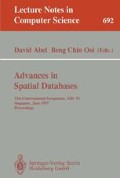Abstract
The conventional method of referencing a point on a spherical surface of known radius is by specifying the angular position of φ and A with respect to an origin at the centre. This is akin to the ≪x,y≫ coordinates system in R 2 cartesian plane. To specify a region in the cartesian plane, two points corresponding to the diagonal points ≪x 1,y 1≫ and ≪x 2,y 2≫ are sufficient to characterize the region. Given any bounded region, of 2h×2h an alternate form of referencing a square subregion is by the linear quadtree address [10] or quadcode [13]. Corresponding encoding scheme for spherical surfaces is lacking. Recently a method similar to the quadtree recursive decomposition method has been proposed independently by Dutton and Fekete. Namely, the quaternary triangular mesh (QTM) [4] and the spherical quadtree (SQT) [8]. The addressing method of the triangular regions suggested are very similar. We present a new labeling method for the triangular patches on the sphere that allows for a better and more efficient operation and indexing on spherical surfaces.
Preview
Unable to display preview. Download preview PDF.
References
R. Bayer and E. McCreight. Organization and maintenance of large ordered indexes. Acta Informatica, 1:173–189, 1972.
Z. T. Chen. Quad tree spatial spectra — its generation and applications. In Proc. International Symposium on Special Data Handling, pages 218–237, 1984.
D. Comer. The ubiquitous b-tree. ACM Comput. Surveys, 11(2):121–137, Jun. 1979.
G. H. Dutton. Geodesic modelling of planetary relief. Cartographica, 21(2&3):188–207, 1984.
G. H. Dutton. Locational properties of quaternary triangular meshes. In Proc. 4th Int'l Symp. on Spatial Data Handling, pages 901–910, Zurich, Switzerland, 1990.
G. H. Dutton. Planetary modelling via hierarchical tessellation. In Proc. Auto-Carlo 9, ACSM-ASP, pages 462–471, Baltimore, U.S.A., 1989.
G. H. Dutton. Zenithial orthotriangular projection.
G. Fekete. Rendering and managing spherical data with sphere quadtrees. In Proc. Visualization '90, pages 176–186, San Francisco, 1990.
G. Fekete and L. S. Davis. Property spheres: a new representation for 3-d object recognition. In Proceedings of the workshop on Computer Vision: Representation and Control, pages 192–201, Annapolis, MD, April 1984. (also University of Maryland Computer Science Tech Report-1355).
I. Gargantini. An effective way to represent quad-trees. Comm. ACM, 25(12):905–910, Dec. 1982.
I. Gargantini. Linear octtrees for fast processing of three dimensional objects. Comput. Gr. Image Process., 20(4):365–374, Dec. 1982. File=D4B, *.
M. F. Goodchild and Y. Shiren. A hierarchical data structure for global geographical information systems. Graphical Models and Image Processing, 54(1):31–44, Jan. 1992.
S. X. Li and M. H. Loew. Adjacency detection using quadcodes. Comm. ACM., 30(7):627–631, Jul. 1987.
S. X. Li and M. H. Loew. The quadcode and its arithmetic. Comm. ACM., 30(7):621–626, Jul. 1987.
F. D. Libera and F. Gosen. Using b-trees to solve geographic range queries. Comput, Journal, 29(2):176–181, 1986.
D. M. Mark and J. P. Lauzon. Approaches for quadtree-based geographic information systems at a continental or global scales. In Proc. Auto Carto 7, Digital Representation of Spatial Knowledge, Amer. Soc. of Photogamm., Falls Church, Virginia, Mar. 1985.
D. M. Mark and J. P. Lazon. Linear quadtrees for geographic information systems. In Proc. Int'l. Symp. on Spatial Data hasndling, pages 412–430, Zurich, Switzerland, Aug. 1984.
E. J. Otoo. Semi-Quadcode and Its Operations on Spherical Surfaces. Technical Report, School of Computer Science, Carleton Univ., Ottawa, Canada, 1992.
H. Samet. Applications of Spatial Data Structures. Addison-Wesley, Reading, Mass., 1990.
H. Samet. The Design and Analysis of Spatial Data Structures. Addison-Wesley, Reading, Mass., 1990.
W. Tobler and Z-T. Chen. A quadtree for global information storage. Geographical Analysis, 18(4):360–371, Oct. 1986.
Author information
Authors and Affiliations
Editor information
Rights and permissions
Copyright information
© 1993 Springer-Verlag Berlin Heidelberg
About this paper
Cite this paper
Otoo, E.J., Zhu, H. (1993). Indexing on spherical surfaces using semi-quadcodes. In: Abel, D., Chin Ooi, B. (eds) Advances in Spatial Databases. SSD 1993. Lecture Notes in Computer Science, vol 692. Springer, Berlin, Heidelberg. https://doi.org/10.1007/3-540-56869-7_29
Download citation
DOI: https://doi.org/10.1007/3-540-56869-7_29
Published:
Publisher Name: Springer, Berlin, Heidelberg
Print ISBN: 978-3-540-56869-8
Online ISBN: 978-3-540-47765-5
eBook Packages: Springer Book Archive

